History
A professor from Wrocław does research on the water in the Auschwitz II – Birkenau camp on the orders of Himmler. In his expert opinion, the water is not even suitable for washing out mouths
Reichsführer Heinrich Himmler visits the camp, and the decision of constructing a satellite camp around the village of Brzezinka is made; it should have a capacity of 100 thousand prisoners. The Reichsführer also repeats the demand of increasing the number of prisoners at base camp from ten thousand to thirty thousand.
The intensive construction of Auschwitz II – Birkenau is begun. It should have a capacity of 97 thousand prisoners and cost 8.9 million Reichsmarks. It is constructed by Soviet prisoners of war, who make a forty-minute journey every morning to the construction site and return every evening to the Auschwitz I camp, where they are quartered
The plan of constructing the Auschwitz II – Birkenau camp is re-evaluated. Instead of brick buildings in sectors BII and BIII, wooden prefabricated buildings that originally served as the army stables will be used. The material for their construction arrives to the camp at the beginning of spring 1942.
The construction of four crematoriums in the Auschwitz II – Birkenau camp is decided at a special meeting. Although we cannot be sure that the idea of establishing gas chambers directly in crematoriums is talked about at this meeting, it is certain that the decision of transporting bodies from Bunker I and Bunker II is made. Also, the immense number of dead that the crematoriums are to cremate indicates much.
Engineers and architects now must know what the equipment really will be meant for. Thus, the number of Germans, i.e. the civilian employees working at the various constructions sites, who know about the mass murders at the camp is not small.
FEBRUARY 1943
119 Jewish boys aged 13 to 17 are transported to the camp from Zamość; the boys are probably dispossessed orphans that the Germans have caught. They are kept in civilian clothing and are placed in the men’s camp at BIId in Auschwitz II. – Birkenau. The boys come across as apparitions. The prisoners arrange for a ball and play football with them in the camp. At the same time, however, all of the male prisoners are worried what is going to happen to the boys.
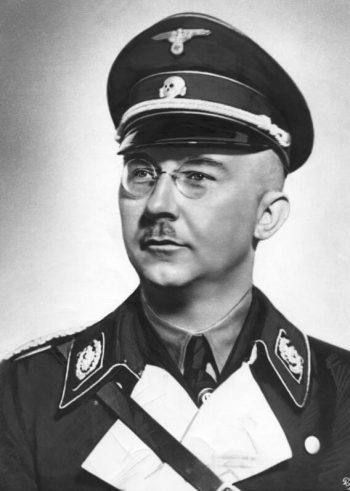
39 boys interned in Block BIId are selected. They are told to strip bare in the washroom, and are presented to the SS medics one by one; they are murdered by phenol injections applied directly to the heart. This task is assigned to medics Herbert Scherpe and Emil Hantl.
After killing several boys, Scherpe has a mental breakdown. He refuses to kill any more boys. Hantl, however, finishes off the killing.
Scherpe is surprisingly promoted and transferred to Golleschau.
The first transport of Romanis leaves Germany for the Gypsy Family Camp, located in sector BIIe in the Auschwitz II – Birkenau camp. The Romanis lived together in the camp, and even had civilian clothing. The sector is quite a mess, and infectious diseases thrive there.
The fatal and disfiguring disease noma quickly spreads especially among the young. It is this very disease that later interests Dr. Mengele, and thirty-six-year-old Jewish doctor Berthold Epstein, who led the Children’s Hospital in Prague before the war, aids him in his research. He tried to escape persecution by going to Norway, where he was arrested and handed over to the Nazis. His family dies in the gas chambers, and he works as a camp physician. He also helps Mengele with his experiments on Jewish children. He survives his stay at the camp and the war.
The so-called general appeal takes place in the Auschwitz II – Birkenau camp, in which Nazi doctors select the ill and weak from all of the commandos and send them to their death. The selection takes place outside, and prisoners must strip naked in the freezing cold. That is why some of those who pass selection later get pneumonia, and their fates are sealed.
In the men’s sector BIb, this selection literally empties Block 7 where the hospital is located, and over 1,000 women from women’s sector BIa do not pass selection. All of those selected are led to the blocks of death, and their lives are ended in the gas chambers in the following days.
The women are transported already naked to the crematorium on the hull of the lorries, and are dumped into a pile in the courtyard. Many are too weak to stand up, and so they are carried into the gas chambers by members of the Sonderkommando. All prisoners know what awaits them; they have already been in the camp for some time and they know its secrets. They are in such a devastated state that they can hardly put up a fight.
Similar scenes occur every time the selected prisoners are executed. According to their testimonies, these are the worst moments for members of the Sonderkommando. They are embarrassed that they are strong, clean, and well-clothed, whereas the victims of the selection are emaciated, have lice, and are dirty.
On this day, the fates of the 80 remaining Jewish boys from Zamość are sealed. The entire event has the same course as the mass murder of their colleagues a week earlier. The boys are again told to strip down, and then they receive phenol injections. Except this time, Scherpe is replaced by Josef Klehr, who does not hesitate nor does he breakdown. Thus, all
are killed, even the eldest, who could have certainly worked in the camp. The only thing left in the block reminding one of the boys is the orphaned ball.
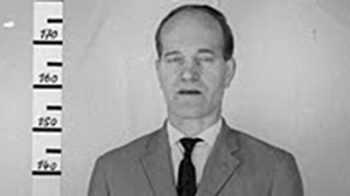
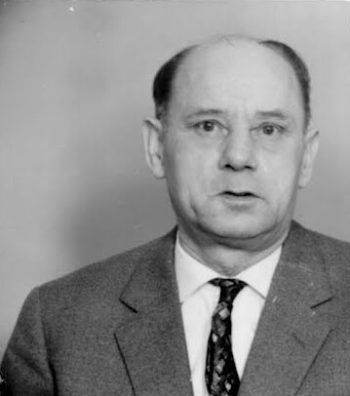
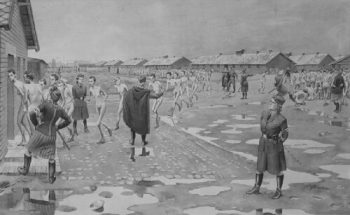
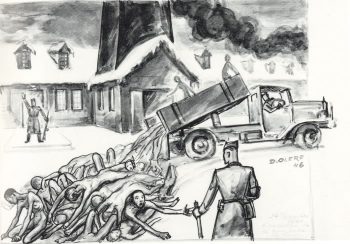
Prisoners in the Auschwitz II – Birkenau camp are moved about. Male prisoners from Block BIb are moved into BIId, and the women’s camp is expanded to all of sector BI.
New accommodation is arranged also for the members of the Sonderkommando. They are assigned to isolated Block 13 in sector BIId. This block is surrounded by a high wall, and its entrance is guarded by a chosen prisoner from the Sonderkommando.
The accommodation blocks in sector BII consist of wooden barracks of prefabricated parts, originally meant for the stabling of 52 horses. They are 40.7 metres long, 9.5 metres wide, and 2.6 metres high. They are divided into 18 boxes. Two blocks near the entrance are reserved for scribes and for the block commandants. Three-storied bunks 2.8 metres in length, 1.8 metres in width, and 2 metres in height serve the quartered inmates. Usually, five prisoners have to cram into one bunk. Sometimes, eight hundred prisoners are housed in one such block.
A family camp for Czech Jews in Auschwitz II – Birkenau is established. They arrive in a transport from Theresienstadt, carrying a total of 5,006 people. In contrast to all of the other deported, they do not undergo selection, and they are even allowed to keep their belongings and do not have their hair cut. They are placed in sector BIIb with the note that they are in a six-month quarantine period.
The reason why this camp is established is never explained. There are assumptions that the Nazis need it for propaganda reasons, showing the good conditions that the Jews have in concentration camps.
The arrival of 2,491 Czech Jews from Theresienstadt to the family camp in sector BIIb in Auschwitz II – Birkenau. Again, they do not have to go through selection and they remain alive.
A transport brings another 2,471 Czech Jews from Theresienstadt to the Auschwitz II – Birkenau camp, and again, they are housed in sector BIIb without going through selection.
Although men and women live separately in the family camp, they are located in the same sector. The adults work in various commandos, and about five hundred children under 15 years of age are allowed to be educated. Twenty-seven-year-old teacher Fredy Hirsch establishes a school in Block 31. He stages performances with the children for the SS officers. Shortly before the first group of deported prisoners’ six-month quarantine period ends.
Communication between the resistance group in Auschwitz II – Birkenau and the members of the Sonderkommando is established at the end of the year. On one side, contacts are held up by the member of the special commando, Slovakian Jew Filip Müller, and later Kapo Kaminski, as well; on the other side, workers of the locksmith workshop, forty-four-year-old Ota Kraus and thirty-two-year-old Erich Kulka communicate.
The chroniclers Lejb Langfuss, Salmen Gradowski and Salmen Lewenthal work on recording the events occurring by the crematoriums. They bury these reports in various places in the Death Zone so that they can later serve as evidence against the Nazis.
Some records are found, but most are probably destroyed after the war by “treasure hunters”, local people who scour the camp lands in the hopes that they can find any valuables hidden by the Jews on their way to death, or any buried loot of the Sonderkommando members used for trading with the Nazis
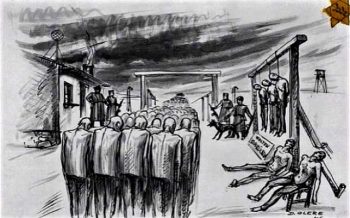
The thirty-five-year-old Kapo of the Sonderkommando, Daniel Obstbaum, attempts to escape. He bribes an SS officer named Dobrowolny, who promises to help him and four other prisoners escape. One of them is also Slovakian camp scribe Fero Langer. Once Dobrowolny gets his reward, either he alone or with his colleagues shoots the prisoners. Aside from the riches he gained, he also gets a bonus week-long vacation for preventing the escape of five prisoners.
200 prisoners from the Sonderkommando are chosen to be sent to Majdanek, supposedly as specialists in operating crematoriums. As they learn later, however, they are immediately shot or cremated upon arrival to the new camp. Some members of the Sonderkommando believe that this is retaliation for the January escape attempt, and serves as an act of intimidation.
The camp is visited by Adolf Eichmann, who also inspects the family camp of the Jews from Theresienstadt; he has Fred Hirsch elaborate a report on the education of the children. However, as soon as 1 or 2 March 1944, he orders that all men, women, and children who have been in the camp for a half a year be murdered.
On 2 March 1944, all of those to be supposedly deported must write to their relatives. The postcards are dated 25 March 1944. They are told that they are being sent to a work camp in Heidebreck in Upper Silesia.
People of the first transport of the Theresienstadt Jews in sector BIIb of the family camp in Auschwitz II – Birkenau are taken at night to the quarantine sector of BIIa. They are again told that they are to be deported to work in Heidebreck. Members of the resistance repeatedly warn them that they are to be murdered, but since they went to an adjacent sector and not to the gas chambers, many think that this is just a rumour.
The Czech Jews from the family camp whose half-year quarantine period is over are gassed. Of the original 5,006 people, about 1,000 of them have died of illness or exhaustion and others are meant for annihilation. Despite the efforts of some Nazis to change the orders by suggesting that a selection be made, leaving those men and women able to work to live, the orders to kill all of those who arrived at the camp from Theresienstadt on 9 September 1943 are upheld. Only a small fraction of them are spared, those that are ill, work in special commandos, or are medics. As well as twins, who are taken to a special block by Dr. Mengele. Forty-one of these spared people end up surviving the war.
Those that are to be killed have been repeatedly warned in advance by the resistance and are urged to revolt. They do not believe such a scenario, as the Nazis assure them that they are to be deported. The resistance relies on the largest persona of sector BIIb, on Fredy Hirsch, who runs a school for about 500 children. However, he commits suicide the evening before the massacre by poisoning himself. This despite the fact that he had the guarantee of the Sonderkommando that in the case of an uprising, it members would join him and fight alongside him. Even sector BIId, the men’s camp, is also ready to revolt.
In the end, no resistance is made. When the sentenced arrive at Crematoriums II and III, it is too late to revolt. Many believe that those sentenced to death will not fight the desperate fight with the Nazis because of their children. They are so afraid of great suffering in the case of an unleashed uprising and the ensuing violence that they would rather die with them in the gas chambers. Indeed, even Hirsch would rather kill himself than to witness his beloved children suffer and die.
The entire gassing takes a very long time. Before several groups undress, others are already waiting, naked, in the gas chambers or are still dressed in the courtyard, aware that they shall soon die. The bruised and desperate people start to sing the Czechoslovak state anthem immediately after the door of the gas chamber closes, then they also sing the Hebrew song “Hatikva”, which is the present-day anthem of Israel. They cannot finish this song, as the gas is already suffocating them.
On this night, 3,791 men, women, and children die. Other sources list a total of 3,798 victims.
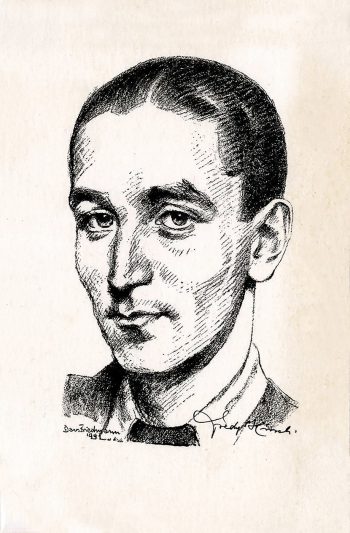

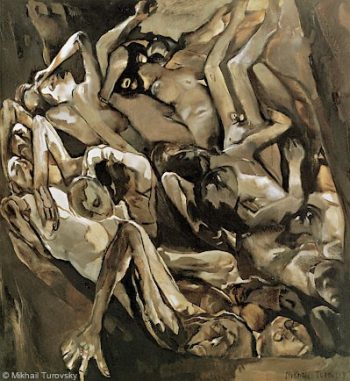
A new railway ramp is built, to be located inside of the Auschwitz II – Birkenau camp and which transports the victims de facto almost all of the way to the courtyard of Crematoriums II and III. The preparations of murdering a large number of Hungarian Jews are culminating. All of them are to be liquidated, and because there are more than 750 thousand, all available camp facilities meant for mass murders are to be used.
Crematoriums II and III operate with only occasional cutbacks from the end of 1943, whereas Crematoriums IV and V are not in operation at all. As a matter of fact, Crematorium IV has been defunct basically since its launching. They are now revised and repaired, including the doors leading to the chambers by the ovens.
On this occasion, the problem of how to kill smaller groups of victims by gassing is solved, as another partition is built in Crematorium V, dividing the smallest gas chamber into two parts. Thus, a small gas chamber with an area of 12 metres squared is established, where a smaller group of people can be killed without wasting gas.
Testimonies about the operations of Crematorium IV diverge, either it launches operations for only a very short time, or it is in such bad shape that it can no longer be repaired and remains to be shut down. In any case, it serves as the quarters for some of the Sonderkommando, and thus logically does not fulfil its original purpose.
Since the ovens of Crematoriums IV and V cannot endure the high performancz in the long run, and their throughput is low, open-air pits for the cremation of cadavers are dug out near Bunker II and behind Crematorium V.
Bunker II is repaired and wooden shacks for undressing victims near it are again constructed. At this point of the camp’s existence, it is sometimes referred to as Bunker V. It is not clear how many wooden buildings for the undressing of victims stand by Bunker II at any given time. Testimonies diverge in the number of two or three. It is possible that in the first and second phases of the operations of Bunker II, the number of buildings differs.
Forty-year-old prisoner Vítězslav Izrael Lederer escapes, and he is aided by twenty-year-old SS-Rottenführer Viktor Pestek, who gets him a SS uniform and leads him out of the camp in it.
During his internment, Lederer establishes contacts with SS officer Pestek, who is in love with imprisoned Czech Jew Reneé Neumanová. It is interesting to note that Pestek also offers to help Vrba and Wetzler escape, but they are afraid of his betrayal and refuse him.
The escape is a success and Lederer survives the war. Pestek, however, decides to also help inmate Neumanová escape. He is revealed, arrested, tortured, and later is sentenced to death right in Auschwitz. However, his execution is carried out on 8 October 1944 in Miedzybrodzie Bialskie.
Two prisoners, scribes from the men’s sector of Auschwitz II – Birkenau, escape. They are twenty-year-old Rudolf Vrba, whose real name is Walter Rosenberg, and twenty-six-year-old Alfred Wetzler. Both successfully escape and reach Slovakia, where they survive the war. Both of them carry on them much information about the events at the camp, which they carefully gathered while planning their escape. Through Filip Müller, a member of the
Sonderkommando, they even get data about the gas chambers. Later, Vrba pens the book “I Escaped from Auschwitz”.
Both elaborate a report on the events of the camp and submit it to the Jewish Council in Switzerland. Then the Allies receive the report. On 18 June 1944, the BBC broadcasts some information from it, and on 23 June 1944, neutral Sweden receives a copy of the Auschwitz Protocols, and the Vatican gets one in October.
Their report is updated after the escape of two more prisoners, Czeslaw Mordowicz and Arnošt Rosin.
A positive result of these reports is the halting of the deportation and murder of Hungarian Jews. However, Jewish prisoners in Auschwitz, as well as other members of this persecuted nation that are yet to be transported there, are left to their own fates. Many thus feel betrayed by everyone and will never understand why the Allies never bombed this death factory and its access railways, on which more and more victims of the Holocaust have yet to arrive.
A new Oberkapo of the Sonderkommando, Karl Koevent, arrives from Majdanek. He also brings with him 19 Soviet prisoners of war. They confirm to the members of the Sonderkommando that their 200 colleagues deported in February 1944 were immediately shot and cremated after arriving at Majdanek.
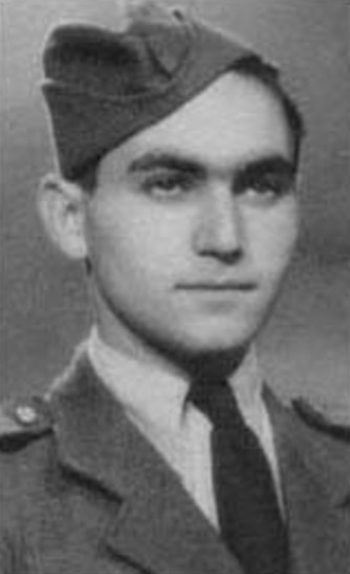
Another pair of prisoners successfully escapes the camp, thirty-two-year-old Arnošt Rosin and twenty-three-year-old Czeslaw Mordowicz. They update the information on the murdering of the Jews provided by their colleagues Vrba and Wetzler.
Rudolf Höss returns as the head commandant of the Auschwitz camp complex, and the preparations of the murders of the Hungarian Jews are finished. The present commandant, Arthur Liebehenscheld, is reassigned as commandant of the Majdanek concentration camp.
9 MAY 1944, TUESDAY
Höss names Otto Moll as the overseer of all crematoriums, and Voss remains the head of Crematoriums IV and V. Höss finds the fanatic and brutal Moll to be more appropriate for the planned, monstrous act than the more moderate Voss.
Moll immediately checks the states of all of the crematoriums and orders them to be repaired. Besides this, he also has the defunct Bunker II be again prepared for use, and the undressing shacks are again built nearby it. He orders four open-air pits for cremating be dug out behind Bunker II.
Since it is soon evident that the crematoriums cannot maintain the pace of cremating the cadavers, and because Crematorium IV is non-functioning and Crematorium V has damaged ovens and thus has a lower performance, Moll has two large open-air pits of about 50 metres in length, eight metres wide, and two metres deep dug out. He has small channels and a sump for the collection of the human fat that will be poured over the cadavers. This improvement should increase the speed of body cremation.
The bottom of the pit consists of old frets, wood, wood shavings, sawdust, and dry fir branches, and prisoners place up to 400 bodies of men, women, and children on top of this layer. The bodies are covered with another layer of flammable material. Thus, up to 1,200 cadavers can be placed into the pit. Old rags, soaking wet with flammable fluids, are stuck between the bodies. Everything is then set on fire with a torch. After the fire flares up, human fat drips into the sump, and it is used to pour over the entire pyramid. A bit later, another several hundred bodies are thrown into the fire.
In order to prevent the burning pits to be seen, a camouflage fence of weaved branches was built around it. Moll had benches and tables set up in front of Crematorium V for undressing. The dressing room inside of the building is insufficient and using it would slow down the murdering process.
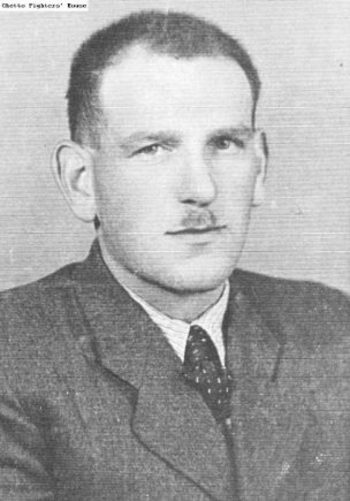
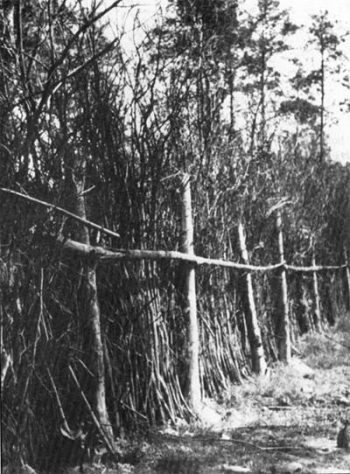
Around this time, a transport from Theresienstadt of 7,503 people arrives at the family camp in sector BIIb in Auschwitz II – Birkenau; one third of these are Czech Jews.
Eichmann’s campaign officially begins, the goal of which is to completely annihilate the Hungarian Jews. That day, three cattle trains arrive from Hungary, carrying about 9,000 to 10,000 people. This number of deported people becomes the norm for each of the following days.
In light of the large number of transported Hungarian Jews, the deported women are placed into the unfinished sector BIII, known as Mexico. Block BIIc, which was meant for them, could not fully accommodate them. Also, with some of the transports, a larger number of people were chosen to go to the camp, and were selected for death only later, when the number of those murdered was lower.
Until this time, the members of the Sonderkommando have been quartered in Block 11 and 13 in sector BIId. Since there is so much work servicing the crematoriums, Moll decides that the commandos will be accommodated directly in the crematoriums. In Crematoriums II and III, a dormitory is constructed in the attic space, and around 200 prisoners works in each one of them. About 300 members of the Sonderkommando serving Crematoriums V and the pits behind it are quartered in non-functioning Crematorium IV. The rest most probably sleep in Block 11 or 13, and they work in Bunker II. Sometime later, they, too, are moved to Crematorium IV.
Seventeen-year-old Morris Kesselman is assigned to the Sonderkommando, and he becomes the pipel of twenty-six-year-old Kapo Lemke Pliszsek. Both survive, Morris thanks to the protection of the Kapo. Later, both give significant testimony about the events near the gas chambers. Being the youngest member of the commando, Kesselman is often sent for food. He is able to coax the guard, an SS officer of Dutch descent, and sometimes, he is allowed to throw bread into the women’s camp. At the time, the Sonderkommando has enough food from the transport loot.
The first transports of prisoners to other concentration camps are sent out. Some of them even contain the recently arrived Hungarian Jews. Similar transports are put together in the next months.
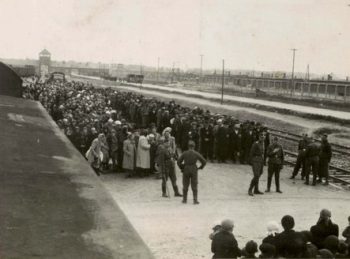

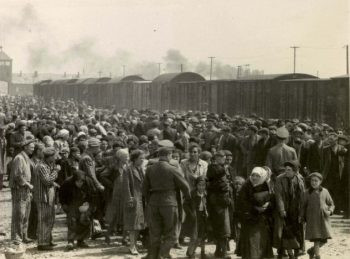

Hungarian Jew Ema Stern arrives in a transport. She eventually survives the camp. In her testimony, she describes that shortly after being admitted to the camp, they took her and other women around a large pit containing naked children’s bodies of various ages, from infants to taller preschoolers. The Nazis are just pouring flammable liquids on them in order to set fire to them. She believes that the SS officers show them these atrocities on purpose, in order to intimidate them and to arouse despair in them.
The New York Times publishes an article based on the Vrba-Wetzler report, which mentions that 1.5 and 1.75 million Jews have been gassed in Auschwitz. At this time, the Swedish king, the Pope, and the chairman of the Red Cross contact the Hungarian regent Miklós Horthy, and request that the deportation of Hungarian Jews to Auschwitz be halted.
The last convoy of Hungarian Jews before a pause in gassing arrives, and the next does not arrive until 28 June 1944.
The Soviets launch Operation Bagration against the Nazi soldiers, which is a massive offensive on Army Group Centre in Belarus.
An Air Force plane takes photographs of the entire Auschwitz complex. At the time, the crematoriums are not in operation, and no smoke is rising out of them. This is grist to the mill for those who doubt the Holocaust and the murders in the gas chambers. The truth of the matter is that the last transport arrived on 18 June, and the next will not arrive for two days more. The images were thus taken when there was a pause in the mass murders.
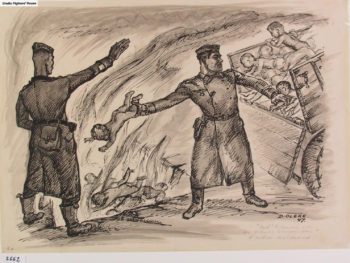
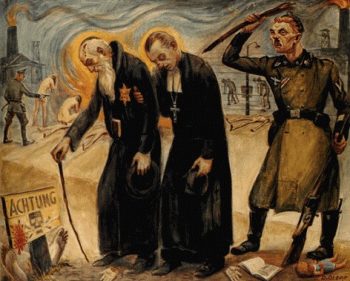
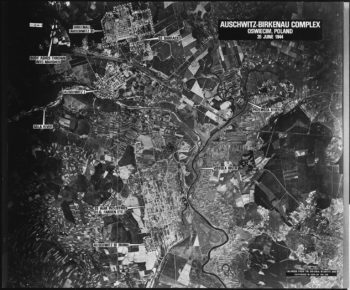
Another transport of Hungarian Jews arrives.
Dr. Mengele sends the decapitated head of a twelve-year-old boy to the Anatomy Institute, and also sends a photograph of four Romani that he has castrated. Aside from various internal organs and serums made out of them or the gauged out eyes of Romanis, Mengele also sends the skeletons of dwarves or of the handicapped from the camp.
It is Dr. Mengele who takes substantial advantage of the transports of Hungarian Jews, choosing them as subjects for his research. He walks among the selected, pulling aside twins from the crowd, as well as the physically deformed, and dwarves. He establishes a special block for them, where he gathers them. The interned themselves call the quarters a freak show.
As for the expertise of Dr. Mengele, he is probably not even a brilliant scientist as is later portrayed in many films and books, but is, at most, an average scientist. He probably is not even a sadist, just a completely unscrupulous physician who values the Jewish prisoners in the same manner as laboratory rats. Jewish doctors are the exception, as he partially considers them to be colleagues. In fact, he sometimes organises something like a conference that the Jewish prison physicians take part of and where they discuss medical issues with him.
Most of his experiments can be considered to be nonsensical and do not bring any significant findings, only the suffering of victims. Whether it is an attempt to change eye colour, standing on one’s head for extensive periods of time, constricting limbs, piercing needles into spines, shining sharp lighting directly into eyes, and so on.
As for the twins, Mengele only kills them exceptionally and usually only when one of them dies of natural causes due to sickness. According to statistics, about 15% of the twins he studies die, which, in terms of the enormous death rate of the camp, is a very solid number.
The children themselves, especially those in the Gypsy Family Camp, like him and call him “uncle Pepe”, and he gives them chocolate and candy. Unfortunately, he also takes them for his various beastly experiments. According to the testimonies of those twins who survived, the children know that if not for Mengele, they would have been already dead. They did not go straight to the gas chambers upon arrival only thanks to the fact that he wants to study them. This is the price they pay for letting him do his experiments on them. The children understand that only his experiments and his interest in them and nothing else keeps them alive. For them, he is both a protector and destroyer in one person.
On his orders, the twins are privileged prisoners and no one is allowed to touch them. Some children take advantage of this and say “I’ll tell uncle and you’ll get it!”. This is a compelling argument, since the doctor ranked as a SS captain is a God in the camp and can literally do anything. It is only the Nazi doctors that can decide who shall live for time still or who is now meant to die.
Mengele does not often join in the sterilisation experiments, and if he does, only marginally. Some testimony suggests that in one case, he removes the testicles of an eight-year-old boy, as it is thought that he wishes to observe and compare him with his twin.
An event with two Romani twin boys is quite telling, however. The prison doctors say that on the basis of x-rays, the boys do not have tuberculosis. Mengele is of a different opinion. A few days later, he approaches them and confesses to the bad diagnosis. When they show their uncertainty, he answers: “Of course I performed autopsies on them.” This is especially sad considering that the eight-year-old boys were not only the favourites of the prison physicians, but also of Mengele himself. All of them literally spoilt them.
The international resistance organisation in the camp called “Combat Group Auschwitz” sets up the “Auschwitz Military Council”, which is to prepare an armed revolt. People are worried that the Nazis will want to kill all of the prisoners and cover their tracks before the Soviet army arrives.
Another reason for the increased activity is the supposed plan of Otto Moll, who suggests that all prisoners be murdered, the crematoriums be destroyed, and then all of Auschwitz II – Birkenau be obliterated by bombing. It is not certain whether Moll suggested this or not, but the information still spreads among the prisoners.
The resistance members even contact the Sonderkommando, which has a great number of strong and determined young men who are aware that in any case, they shall be killed themselves as unwanted witnesses.
Representing the Sonderkommando in these contacts with the resistance is Kapo Kaminski, who pushes for launching the uprising as soon as possible. He is afraid that soon, the ranks of the Sonderkommando will be reduced, i.e. that its members will be murdered. The resistance protests that the conditions are not yet ideal for the escape of a larger number of prisoners, and that the Nazis could then literally hunt the refugees down. The Soviet army is still far away and the SS officers have the opportunity of calling for reinforcements.
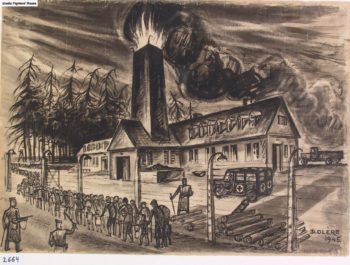
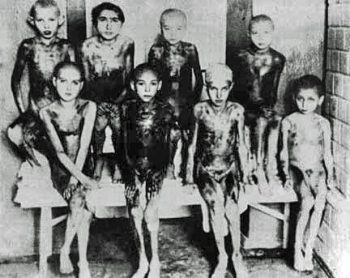
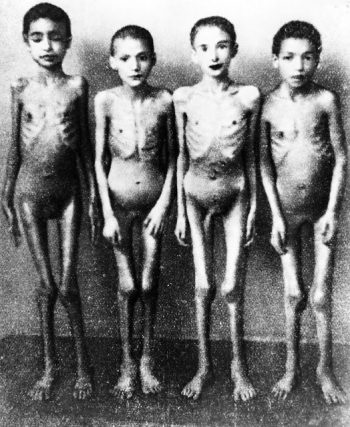
On this day, the representative of Hungary, Admiral Miklos Horthy, decides to halt the deportation of Jews. The reason is the pressure of his own family, as well as international coercion, as every day, he is bombarded with telegrams. This is the only time that diplomatic intervention is able to brake the Holocaust. However, at this time, probably half of the almost 440 thousand already deported Jews are dead.
It is undoubted that the liquidation of the Hungarian Jews is the darkest and bloodiest period in the history of the concentration camp. At the same time, the data on exactly how many Hungarian Jews ended up at Auschwitz and how many of them were killed there differs greatly. The deniers of the Holocaust point out some of the exaggerated numbers in the testimonies, such as 25 thousand gassed and cremated victims in a 24 hour period, as well as the technical impossibility in the given conditions to kill such a large amount of people and get rid of the bodies in one day.
The witnesses themselves are probably so astonished by the mass murders in these months that they are not able to properly estimate the correct number of dead. This only puts grist to the mill of the Holocaust deniers, as do the exaggerated numbers given by the Soviets immediately after the war, who announce a total of 4 million murdered at Auschwitz. Today, historians agree on the realistic numbers of 1.1 to 1.3 million executed or tortured people.
In the period from the beginning of May to the beginning of July 1944, probably 361,661 people are deported from Hungary directly to Auschwitz, as some sources state. Many of those chosen for labour, usually up to 30% of the transport, are then sent to work in other camps. Some that are designated for liquidation are temporarily quartered in the camp and wait for their time to come, that is for when those already murdered are cremated in the crematoriums or in the huge pits behind Crematorium V. The sad, real record is the gassing of 9 thousand people in one day.
According to Nazi records, 437,402 Jews are sent to death from Hungary. How many of them actually die in Auschwitz is not exactly clear, the smallest estimates speak of 150 thousand gassed and cremated immediately upon arriving, other sources cite 200 to 250 thousand. The highest number cited is 320 thousand immediately gassed, but this number seems to be exaggerated, and murdering this amount of people in such a short time is technically difficult to do. Some of the victims counted may have not been murdered upon arrival, but probably die while being incarcerated in Auschwitz, or after being deported to other camps.
After a mass murder in March 1944 of almost four thousand Czech Jews deported from Theresienstadt in October 1943, their colleagues live in the family camp in sector BIIb with the knowledge that their time of six months before being killed is running out. Many apathetically state that they still have two months, then one, then a fortnight before they go up in smoke.
Perhaps because the Nazis are afraid of an uprising, the liquidation of the camp on 20 June 1944 does not occur. On the contrary, the SS officers start choosing men and women capable of working, a total of about 3,500, who are sent to other camps to the west. There, about two-thirds of them later die. At first, these chosen prisoners are wary that being chosen is a manoeuvre to camouflage the fact that they are going to the gas chamber, but eventually, they are relieved to be really travelling in trains heading for other camps. Several tens of strong boys aged 14 to 16 are chosen to work. Twins are, again, led away by Dr. Mengele.
Thus, only the weaker individuals, i.e. older men, women, and children, are left in the family camp. It is also necessary to count several tens of strong women who refuse to be transported in order to stay with their children. So, the Germans let them stay with their daughters and sons. These women probably know what awaits them, but they would rather share the fates of their children than to save their own lives and let their children die alone.
On 12 July 1944, the killing of the remaining six and a half thousand people from sector BIIb, which means the definite liquidation of the family camp made up of the Jews coming from Theresienstadt, takes place. All of the remaining men, women, and children die in the gas chambers of Auschwitz II. – Birkenau.
Edmund Veesenmeyer, the German agent in Hungary, sends a report to Berlin stating that a total of 437,402 Jews were deported. A total of 147 transports were sent out, each carrying a total of about 3,000 people.
The Sonderkommando prepares a very carefully planned uprising. The prisoners should kill the guards in the crematorium around 4:00 p.m. and then wait for the next shift of SS officers, kill them and take their weapons. After being so armed, they shall start liberating the
adjacent sectors of the camp and so unleash a large-scale escape. Everything is ruined by the arrival of 837 prisoners from Majdanek, since they are accompanied by a strong SS officer commando and by the Wehrmacht, who guard them near the crematorium by the Central Sauna, where they are being deloused.
It is clear that the presence of so many armed soldiers means that the entire act is jeopardised, and so Kaminski calls off the entire uprising at the last minute. Those men of the Sonderkommando that were ready to die in battle with the Nazis become apathetic.
Rudolf Höss leaves the post of camp commandant for the second time. He is awarded the “War Merit Cross (with Swords) First and Second Class” for murdering the Hungarian Jews.
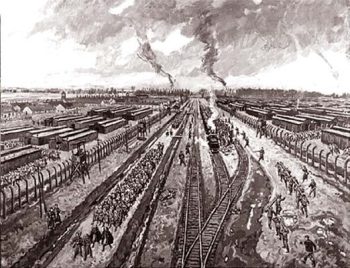
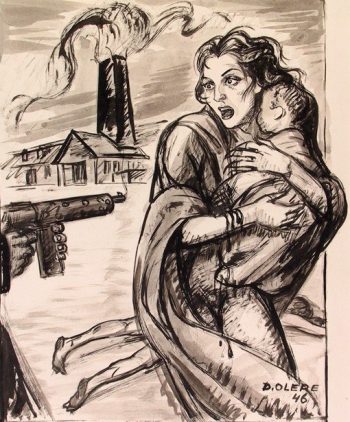
After liquidating the camp of the Czech Jews, it is decided to also liquidate the Gypsy Family Camp. Over two thousand people capable of working have already been transported to other camps, and several thousand have died of natural causes due to horrible hygienic conditions. Others, mostly children, are sometimes purposefully and quietly killed by physicians, which is also designated as death by natural causes. Thus, the number of those to be killed in the final act is decreased. Even so, there are still probably 2,897 men, women, and children who remain in the camp. Some sources, however, cite up to 4 thousand or even 4,500. A total of 23 thousand Romanis go through sector BIIe of Auschwitz II – Birkenau, of which about 2 thousand survive being interned here.
Up until the last minute, Dr. Mengele attempts to save the Gypsy camp, as he has one of his experimental workplaces here; he even personally goes to Berlin because of this. He is not able to prevent the liquidation of the camp, however. So, he helps liquidate it with the same diligence he showed as he tried to save it.
Since the Romanis suspect what is to happen to them, they desperately fight with SS officers and members of the Sonderkommando by the gas chambers, during which they use whatever weapons they can find, such as utensils. Their ferocious fight is futile, however.
Fourteen Romani twins avoid death in the gas chambers, and some sources talk of 12 pairs of twins. Dr. Mengele has them interned in the workplace next to his morgue in Crematorium II. After the gassing is finished, that very night, the children are individually led into the morgue. Here, they have to undress and lie down on the autopsy table. First, they receive an injection into the arm of the tranquilliser evipan, and then a fatal injection of chloroform into the heart. The injections are personally applied by Dr. Mengele, and the autopsies of the twins gradually taken to the morgue are carried out by the pathologists.
These are the very same children that Dr. Mengele himself gave food, candy, and toys to in the camp. And they joyfully welcomed him, ran towards him, every time this nice “uncle” showed up.
The combat group, represented by the “Auschwitz Military Council”, begins preparing the plans for a large uprising, counting on the help of the Sonderkommando.
Ultimately, the uprising never takes place, since for some time now, prisoners are being moved further west, further away from the Soviet army. It turns out that not all prisoners are to be killed, and thus they have a better chance of living to see the end of the war in another camp than in a surely bloody uprising, the positive outcome of which cannot be guaranteed in advance.
An agreement is made between the resistance and the women working in the factory of the “Weischel Union Metallwerke” Company, which manufactures igniters for artillery shells. At least six women, namely Roza Robot, Ester Wajclbjum, Regina Safirrsztajn, Ala Gertner, Marta Cigé and Chaya Koin, participate in the smuggling of gunpowder from the factory into the camp. There, the prisoners make hand grenades using it, which they hand over to Sonderkommando member Jukel Wrobel in the clothing storage. Sometimes, twenty-eight-year-old Eliezer Welbel accepts the material.
The grenades are made out of tin cans, and consist of gunpowder, nails, and shards. Shlomo Dragon hides about 30 such grenades in Block 13. Later, he moves them to Crematorium IV.
On this day, American bombers bomb the oil refinery in Trzebin, lying not even 20 km from Auschwitz. The rising smoke from the hit buildings can be seen. The prisoners, however, wait in vain for the planes to also bomb the camp. Fifteen-year-old Hugo Gryn summarises his feelings into one sentence: “The most painful aspect about life in the camp was the feeling that everyone forgot all about us.”
At this time, it is decided that the ghetto in Łódź will be liquidated, containing about 70,000 people. Their fates are to be fulfilled in Auschwitz. As always, when the transport arrives at Auschwitz II – Birkenau, selection takes place and the majority of the delivered people are gassed. On some days, two trains with the deported arrive.
The first transport of Jews from the Łódź Ghetto arrives. The period of clearing out the ghettos in Łódź and Plaszow begins.
Americans bomb the factory complex in Auschwitz III – Monowitz. The prisoners of Auschwitz II – Birkenau again desperately look towards the heavens and pray that the bombs also hit their camp and the factory of death. Their prayers are in vain. According to their testimonies after the war, most of them at that moment feel totally abandoned and that absolutely no one cares. And nothing about this feeling changes until the end of the existence of the murdering machinery known as Auschwitz.
In fact, the Americans bomb the camp environs four more times, on 13 September, on 18 and 26 December, and on 19 January 1945. They have detailed plans of the camp from
Vrba and Wetzler, as well as photographs from their own reconnaissance, no later than July 1944. Despite this, they decide to not bomb the camp.
The inmates do not accept the explanation that the Americans are scared the bombs will hit the prisoners. They are sentenced to death either way, and they have more hope in the bombing. Not only in destroying the gas chambers, but also of the railways that more victims are brought in on, and also in the chaos that would ensue, in which they could have a chance to escape.
The Allies certainly have justified concerns that if the camp were to be hit, someone like Goebels could point out the charred cadavers in their propaganda. Presumably even David Ben Gurion, the future founder of the state of Israel, dissuades the Allies from bombing. He fears many dead prisoners, as well as the revenge of the Nazis on those who survive.
When experts later deal with these issues and rationally evaluate the situation without emotions, they come to the conclusion that the bombing at the end of the summer of 1944 would not have changed the course of the Holocaust. It probably would not have even saved any of the interned, but would have rather killed more of them.
The deportation of Jews from Plaszow and Łódź continues. On this day, 40 wagons from Plaszow arrive; a smaller amount of Jews are admitted to the camp and the rest are gassed.
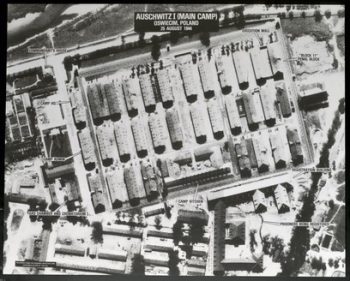
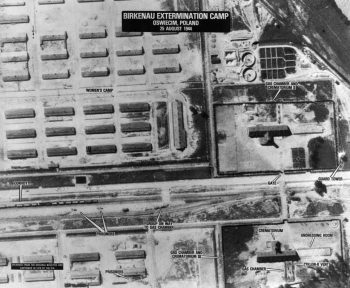
Any further construction of the camp is cancelled. On the contrary, the barracks in unfinished sector BIII in Auschwitz II – Birkenau are taken apart. The materials are then sent west for further use.
The Łódź Ghetto is liquidated, and although the number of the gassed is curtailed, it definitely does not stop completely, as the camp in Theresienstadt still exists.
The Nazis murder 200 members of the Sonderkommando from Crematoriums IV and V, most probably in the disinfection room Canada I. These killed prisoners were quartered in Crematorium IV, near which they are selected for alleged transport to another camp; they almost revolt during this selection, but they eventually obey the commands.
Their death is not really explained, but it seems that they most probably drank with overseer Otto Moll, who is leaving Auschwitz and who promises to take the experienced workers with him to his new place of operation. The Nazis then gas the drunk prisoners.
Then, the Nazis lock the Sonderkommando in the attic of Crematorium II and cremate the bodies of their colleagues in the ovens themselves. Supposedly they are the victims of the bombings. The dead do not burn completely, and so the next day, the prisoners find the charred cadavers in the oven chambers and recognise their murdered colleagues. The atmosphere of hopelessness and apathy only worsens in the Sonderkommando
The overseer of all crematoriums Otto Moll is transferred, and Peter Voss again assumes this post.
At this time, the transports of Jews from Theresienstadt arrive, and most of the deported people go directly to the gas chambers.
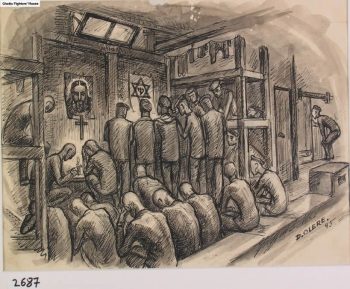
The Jewish prison functionaries of the Sonderkommando get orders from the SS officers to make a list of 300 of their inferiors who should go into the transport. Everyone realises that they are to be murdered. According to the recollections of the surviving prisoners, the Kapos hesitate to obey the command, but eventually this list of death is put together.
The Nazis, as they had many times before, leave the responsibility of choosing those meant for death to their own leaders. This was done earlier in the ghettoes, where the Nazis required lists for the transports, and they are doing it again now.
The Kapos have a dilemma. If they compile the list now, they save themselves and their favourite prisoners. If they do not obey, the Nazis shall choose who will go to the transport
themselves, which could also include them. And the defeat of the Germans is approaching, a large uprising is being talked about and everyone still secretly hopes that the camp could be bombed and they will be able to escape in the chaos. They cling to the hope that they will be saved before their turn comes.
A conflict occurs between a Russian Sonderkommando member and a SS officer. When the guard starts to beat the Russian, he attempts to run, and the SS officer wounds him with a gun. When the guard wants to whisk him away, the wounded man plunges at him. In the ensuing fight, the guard shoots him, and then complains to his colleagues about the Russians and requests their departure. The Russians hear about this and worry that they will all be deported and murdered. Although this never happens, the tensions among them rise.
In the morning, the inmates of the Sonderkommando find out that 300 of its members are to be selected and deported. These are usually the inmates that are quartered in Crematorium IV.
A partial agreement, not accepted by all members, is made saying that they shall defend themselves and they shall begin the revolt in Crematorium IV. They are to set fire to their straw pallets and send smoke signals to their colleagues from the other crematoriums. Signals from Crematorium II should be then aimed at Crematorium III. However, it seems that many Kapos and some inmates do not agree with the revolt and want to wait for the large uprising of the entire camp. They are probably ready to sacrifice their three hundred colleagues. It is a difficult decision to make, and certainly not all members of the Sonderkommando are united in how to proceed. Maybe even some of them already know that they are not on the list.
At 1:25 p.m., there is a roll call for all workers in Crematorium V who are quartered in Crematorium IV. Eventually, 286 men remain in the courtyard, and the other 30 are shut in Crematorium V.
SS-Oberscharführer Hubert Busch and SS-Unterscharführer Johann Gorges try to select those inmates meant for the supposed transfer to another camp. At this time, older inmate Chaim Neuhoff pounces on them with a hammer. Others then join him, and the SS officers start shooting from their pistols and run behind the barbed wire. At the same time, they call for reinforcements.
Twenty-eight-year-old Kapo Shlomo Kirszenbaum organises the escape of about 120 prisoners into Crematorium V, where they hope to hide. Many are wounded or killed. Shlomo Dragon also hides in Crematorium V, whereas his brother Abraham remains lying wounded on the path between the crematoriums. Later, he is transported to the hospital. All of the three mentioned above end up surviving both the uprising and the war, as well.
The rest of this part of the Sonderkommando attempts to continue fighting. At this point, the Nazis are already shooting at them from a safe distance, and soon, reinforcements arrive from the barracks with machine-guns.
The prepared grenades are not available, as Shlomo Dragon refuses to hand them out before roll call, since he is waiting for ord
pallets of Crematorium IV are lit on fire, one can no longer go for the grenades due to the flames. They end up not exploding at all, and are buried under the falling roof.
The uprising is soon squelched, and all of the surviving prisoners must lie down in rows in the courtyard of Crematorium V; every third person is shot. Of the total number of 324 inmates, only 44 survive the uprising and the ensuing retaliation near the forest crematoriums. Shlomo Dragon and Filip Müller successfully avoid the executions in the courtyard, and thus do not have to play with fire to see if they will not be one of those shot.
At first, the uprising does not affect Crematoriums II and III, where it remains to be calm until 1:50 p.m. At this time, a unit of SS officers approaches the crematorium, probably just in case in order to prevent an uprising here, as well. The Russian inmates in Crematorium II panic and pounce on Oberkapo Koevent, shoving him into the oven alive. They then attempt to escape, armed only with several knives, a bayonet, and a few home-made grenades. About 100 members of this Sonderkommando escape from the grounds of the crematorium and even make it over the large ditch. Some of them are shot, but part of the group ends up at the fish pond, where they are confronted with an emergency unit on wheels. In this uneven match, all 73 of the inmates are killed, as well as 3 SS officers, who have their throats slit by the rebels. Another 12 SS officers are wounded, also thanks to the weapons of their colleagues that have been overtaken by the rebels.
There remains one small group of refugees that barricades itself in a barn in the village of Rajsko. The barn is lit on fire by SS officers, and the inmates either burn to death or are shot when they come out of the flames.
The four-member medical team of Dr. Mengele’s pathologists remains in Crematorium II. They are forced to lie down along with the arrested members of the Sonderkommando in the courtyard with their foreheads to the ground. Dr. Mengele soon comes to pick them up and leads them away, but the rest of the inmates are shot in the head. Of the 171 members of the special commando servicing Crematorium II, not one survives the uprising.
Nothing is happening in Crematorium III, as Kapo Lemke Plizsko prevents his inferiors from joining the spontaneous uprising. He waits for orders from the Combat Group and denounces this wayward act of the Sonderkommando. What is tragic is that on this day, he loses his brother, who services the sewage system but joins the rebels, since he thinks that the large-scale uprising is beginning. Thus, this Kapo loses his last living relative.
All 168 inmates from Crematorium III survive the uprising, as do Mengele’s pathologists from Crematorium II and 44 men from the forest crematoriums. On the other hand, 452 of their colleagues die. Three are dead on the side of the SS officers.
Already in the evening, 20 members of the Sonderkommando of Crematorium III must leave to service Crematorium II. Their fears that they are being led to their deaths increase when they are forced to undress after arriving at the opposite crematorium. In this moment, they all think that they will be executed and they begin to say farewell to life. However, the SS officers are just searching their clothing. They are then driven to the ovens, and that evening, they cremate the rest of the bodies lying in the morgues. The next day, they begin to cremate the bodies of their shot colleagues.
1,229 prisoners are sent to the gas chambers following a large selection in the women’s camp. Among these inmates are “teen” girls, i.e. those that are younger than eighteen. This group, however, manages to save themselves on this day. At the time that the Sonderkommando uprising is launched, they are already naked in the gas chamber of Crematorium V, but since it is impossible to go through with their murders in the burgeoning chaos, they are sent back to the camp. Some of them end up surviving the war, even though they were already standing naked inside of the gas chambers. Then fifteen-year-old Alice Lok Cahan gives witness to the event after the war.
There is an interesting factor to her story. Although she has been in the camp for several months, she has no idea where they are leading her, even though her fellow inmates had told her about the gas chambers long ago. She believes it to be a classic delousing of clothing and cleansing. This also shows that many prisoners are only familiar with a certain part of the camp.
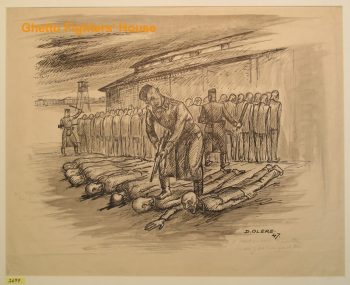
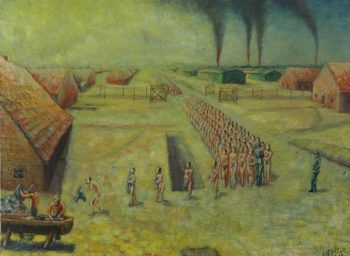
During the night of 9 to 10 October 1944, apparently several members of the Sonderkommando attempt to blast Crematorium III and are caught in the act. 14 inmates are arrested and led to Block 11 in Auschwitz I, including the five remaining Soviet prisoners of war and two significant leaders of the resistance group, Jankiel Handelsman and Jukel Wrobel.
The number of inmates in the Sonderkommando is decreased to 198. They live in the attic of Crematorium III, and about 30 of them go to work at Crematorium V, where they cremate the camp’s dead.
Esther Wajcblum, who works in the Union Factory and smuggles gunpowder, is arrested. She endures torture and does not reveal anything, she is therefore released.
According to estimates, about 40,000 people are murdered in the gas chambers in this period. Among them are over 14,000 prisoners from Auschwitz who are deemed unfit for transport to other concentration camps in the west. These include the ill, the weak, but also people under the age of 18. All of them are sent to their deaths. Only the strongest who are able to work are to remain alive.
A group of inmates from the Sonderkommando commences to remove the remains of the burnt out Crematorium IV. The paradox of the revolt of their colleagues was that they
managed to ruin the only crematorium that was not functional and that served a different purpose.
A command ordering that all boys in Auschwitz under the age of 18 be gassed is made. Some manage to be saved, usually thanks to the prison functionaries and usually by forging their date of birth. The order does not apply to the children that Dr. Mengele uses for his experiments.
Despite of this, the Nazis manage to gather over 600 boys aged 12 to 18. They believe that they are to be transported to work elsewhere, but when they are led to the courtyard of Crematorium III, they realise what awaits them. They have been in the camp for some time and know what purpose the building standing on the courtyard has. Despite of their passive resistance, when they refuse to undress and go towards death, they do not escape their fate. According to the testimonies of the Sonderkommando inmates, this is one of the most horrible scenes that takes place at the crematoriums.
It is probably appropriate to cite the secret records of inmate Lejb Langfuss, which were preserved.
“They were dressed in long, very threadbare striped suits, and had ragged shoes or clogs on their feet. The boys looked so handsome and well-built that not even the rags could cover it up. The boys immediately realised that they were being led to their deaths. They began to run around the courtyard in a panic, ripping their hair from their heads, not knowing how to save themselves. Many of them began to sob, and a piercing wail could be heard. The overseer of the commando and his aide severely beat the boys in order to get them to undress, so much so that they broke their club. Many boys ran in a desperate dash towards the Jews of the special commando, clinging to them and begging for their lives. We stood paralysed by their heartbreaking weeping. The SS officers stood with smug smiles on their faces, without a trace of mercy, with the proud expression of victors, and drove them with great blows into the Bunker.”
A group of fourteen Sonderkommando members, arrested on 9 October 1944, are led to the premises of Crematorium II and shot there.
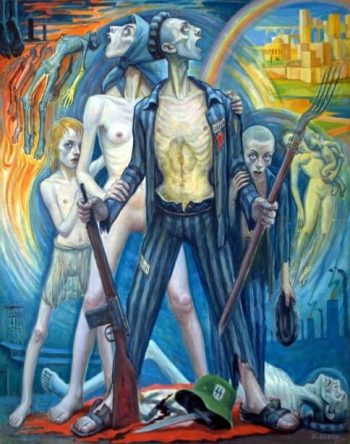
The last use of the gas chambers in the history of the camp occurs. The victims are selected Jews from the transport of about 2,000 people from Theresienstadt. About 15% of them are admitted to the camp.
Some sources cite that this last mass murder in the gas chambers takes place four days earlier, i.e. on Tuesday, 24 October 1944.
In the period from June to the end of October 1944, over 70 thousand inmates are sent from the complex of camps at Auschwitz to other concentration camps further west. They are transported on the railways.
Crematoriums II and III are shut down, and inmates are variously moved about in the Auschwitz II – Birkenau camp. The dismantled barracks in sector BIII travel to the Gross Rosen camp. Interned women are moved to sector BIIb, BIIc, and BIIe. The transports of prisoners further west continue.
The news that the gassing of people has been officially halted spreads among the inmates.
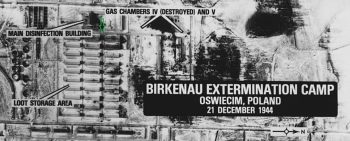
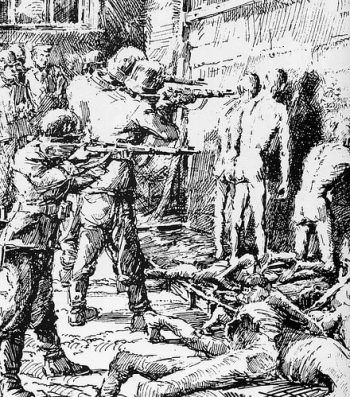
Crematorium II starts to be dismantled. Shortly afterwards, Crematorium III is also begun to be taken apart. All members of the Sonderkommando are assigned to this task, except for the thirty of them who service Crematorium V. The work mostly consists of dismantling the technical equipment that is to be transported further west.
A group of 15 members of the Sonderkommando is sent to collect the straw pallets from Crematoriums II and III. While they are working, a selection takes place in the Sonderkommando, choosing 100 people are taken to and where they are killed. Among them is also chronicler Lejb Langfuss.
According to the testimony of Henryk Tauber, his number was also called out during selection, but since he was with the work unit loading straw pallets, someone else was sent to death. This is just further proof of how the fates of people are decided by happy coincidence. Or by unhappy ones, from the point of view of the inmate that replaced him.
After this action, only 98 men of the Sonderkommando remain to be alive, and 30 of them still work at Crematorium V, and the rest are taking apart Crematoriums II and III.
Prisoner Ala Gertner is arrested, and under torture, she names three other women who participated in the smuggling of gunpowder from the Union Factory. Esther Wajcblum, Regina Safirsztajn, and Roza Robot are arrested. All of them are brutally interrogated. They do not, however, divulged any information about any other participants.
The ranks of the demolition commando of Crematoriums II and III, comprised by the members of the Sonderkommando, is strengthened by a group of 100 women and several other inmates from the camp, mainly experts from the craftsmen units. On 5 December 1944, another 50 women will join them. This is the first time in the histories of Crematoriums II and III that women who enter the premises return from there alive.
Work moves along quickly, aside from the technical equipment, the roofs are taken apart, the ovens and chimneys are dismantled, and even the ceilings of the basements are taken apart. The aim is to cover any tracks of the mass murders.
The surroundings of Auschwitz are bombed.
The public hanging of five inmates who unsuccessfully attempted to escape two months ago. Three Austrians and two Poles die.
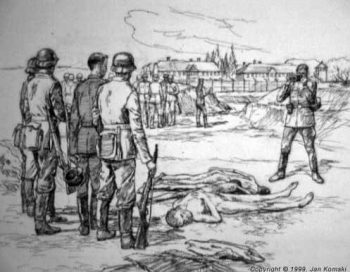
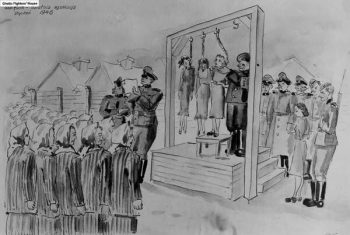
At this time, 270 Polish men and women convicted by court martial are shot on the premises of Crematorium V. Their bodies are immediately cremated in the ovens of the crematorium.
The last reduction of the Sonderkommando; the Polish stokers and Kapos are transferred to the concentration camp in Mauthausen. These are Mieczyslav Morawa, Jósef Ilczuk, Wladislav Biskup, Waclav Lipka and Jan Agrestowski. They are most probably shot in Mauthausen as inconvenient witnesses on 3 April 1945
The last execution of 70 Poles sentenced to death by the German court martial takes place. They are shot.
The women who participated in the smuggling of the gunpowder from the Union Factory are publicly hanged; Ala Gertner, Esther Wajcblum, Regina Safirsztajn, and Roza Robot die. All of them were brutally interrogated before the lynching, but none of them divulged any information about the others involved.
The death marches are being prepared. The inmates are gathered in the Auschwitz I camp. Up to this point, the prisoners were deported in trains, but now they must go by foot. However, the main convoy does not leave until eight days later.
What is left of the Sonderkommando is moved to Block 16 in sector BIId in Auschwitz II – Birkenau; this block is not isolated and they can, for the first time, move freely about the camp.
This is the last day that the members of the Sonderkommando go to work on the demolition of Crematorium II and III. From this day on, they stay in the camp in their block and wait for death. They know that as unwanted witnesses they will not be kept alive. They cannot find any way to save themselves, however.
The last evening roll call of the Sonderkommando takes place, and its members are told to go to their Block 16 and to remain there. They know that once the last regular inmates leave, they will be murdered
Convoys of inmates that have not been transported by train begin to form in Auschwitz I, and they will go to the nearest railway junction by foot. A total of 58,000 prisoners remain in the Auschwitz camps.
Dr. Mengele packs his bags to the sounds of artillery shelling. He then gets into his completely stuffed car and drives off. He leaves his pathologists and his twins to their fates in the camp.
The last phase of the evacuation of the Auschwitz camps begins. Convoys of prisoners set off from Auschwitz I and the so-called death march begins, during which those who cannot keep up are unmercifully murdered. Most often, they are shot by the commando of SS officers that is trailing the convoys and who finish off the exhausted prisoners. The ditches by the roads are full of dead men and women. The deported do not get anything to eat or drink on the way. An estimated 15,000 of the deported do not survive the cold and the exhaustion on the death march and the ensuing train journey.


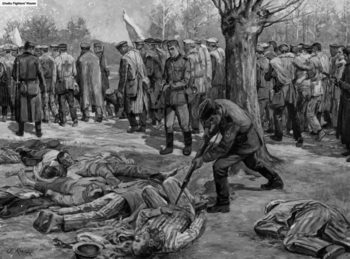
The base camp of Auschwitz I is evacuated, and the remaining members of the Sonderkommando find themselves in the convoys, a mere one hundred of the approximately 2,000 men who worked in the Sonderkommando during the camp’s operations. The rest was murdered in the course of events. Since they are fairly well fed and are well-dressed, they survive the death march and almost all of them live to see the end of the war. About 90 men of this special commando are saved.
Nine members of the Sonderkommando successfully escape already during the death march itself, and their escape is facilitated by their good physical condition. This is how twenty-two-year-old Shlomo Dragon, twenty-seven-year-old Henryk Tauber, thirty-four-year-old Stanislav Jankowski, or twenty-four-year-old Eliezer Eisenschmidt, who is shot in the leg trying to escape but still eludes the Nazis, save themselves.
Another approximately 80 members of the Sonderkommando are liberated by the Americans at the beginning of May in Mauthausen.
It is also necessary to count the other 17 survivors who serviced the gas chambers and cadaver burning at the Bunkers in 1942, but managed to get into other commandos during the early phase of this horrible work.
On this day, the remaining parts of Crematoriums II and III yet to be dismantled are blasted.
Shortly after Crematoriums II and III are destroyed,their siblings and never see them again. Most of the children, however, survive the march and are interned in a new camp, where chaos now reigns the “abandoned” Mengele twins are forced to go by foot to the Auschwitz I camp, during which several younger children are shot as they cannot keep up with the tempo of the journey. Two of the twins thus forever lose
About 9,000 prisoners who were too weak for transport remain in the Auschwitz camp complex after evacuation. Their liquidation is ordered, but luckily at this time, the SS officers are more interested in their own salvation than in obeying commands.
The SS units spend most of the time outside of the Auschwitz I and Auschwitz II – Birkenau camps, the strict control of the guards and Kapos ends, and the prisoners in the camps are left to their own fates. Despite this, the SS attempt to enter the camps several times and to obey the command to kill the remaining prisoners, but they end up shooting only about 300 people. Another several hundred inmates who remained in the satellite camps are also murdered. It is estimated that a total of 700 inmates were shot in these January days. However, other people die thanks to their illnesses or to exhaustion.
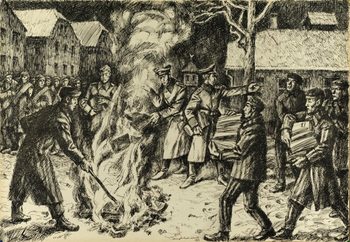
Erich Kulka and his twelve-year-old son escape from the transport in Ostrava-Přívoz around midnight. They hide out until the arrival to the Soviet army, and they live to see freedom on 2 May 1945 in Zlín. Along with his fellow prisoner Ota Kraus, Eric Kulka publishes his experiences in Auschwitz in the book “The Death Factory”.
At 1:00 a.m., Crematorium V is blasted, the only crematorium still in a functional state up until then.
At 3:00 p.m., Soviet soldiers arrive at Auschwitz, and they find 7,400 prisoners that survived here. Among the survivors are the twins of Dr. Mengele. Of the surviving prisoners, 1,200 of them are in Auschwitz I, 5,800 in Auschwitz II – Birkenau, and 600 in Auschwitz III – Monowitz.
Gallery
- Všechny kategorie
- 3D Model
- Technical draw
















